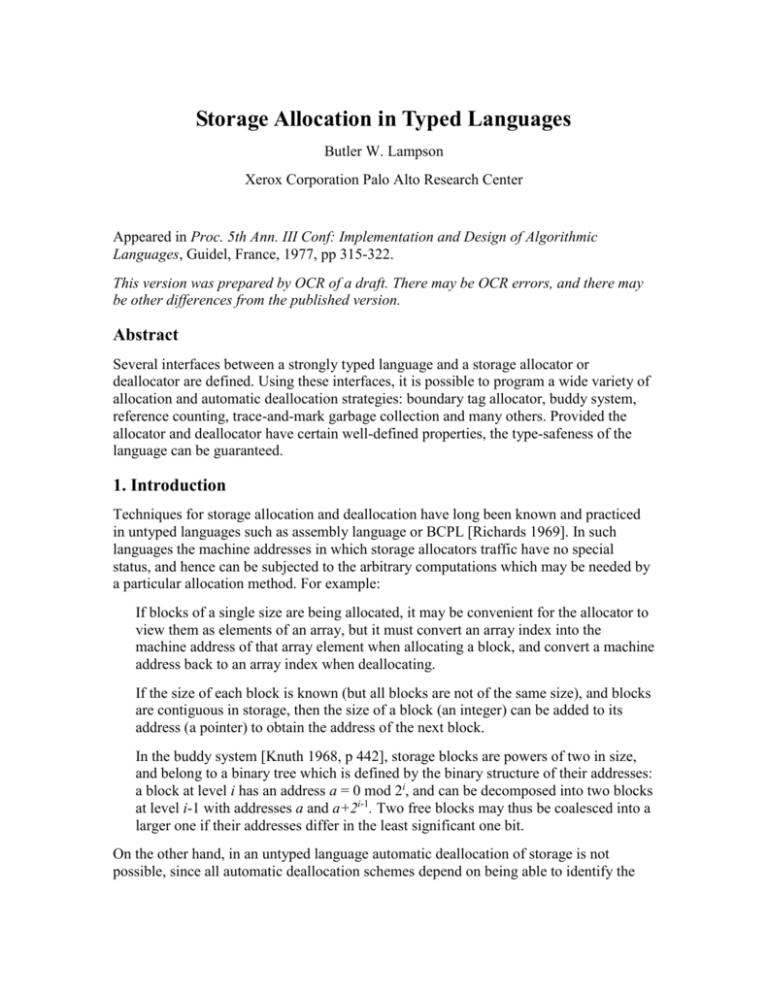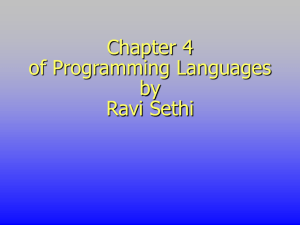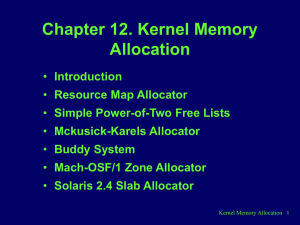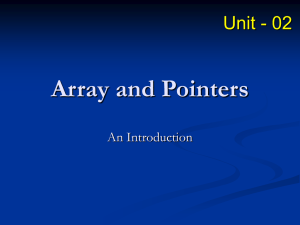Word - Microsoft Research
advertisement

Storage Allocation in Typed Languages
Butler W. Lampson
Xerox Corporation Palo Alto Research Center
Appeared in Proc. 5th Ann. III Conf: Implementation and Design of Algorithmic
Languages, Guidel, France, 1977, pp 315-322.
This version was prepared by OCR of a draft. There may be OCR errors, and there may
be other differences from the published version.
Abstract
Several interfaces between a strongly typed language and a storage allocator or
deallocator are defined. Using these interfaces, it is possible to program a wide variety of
allocation and automatic deallocation strategies: boundary tag allocator, buddy system,
reference counting, trace-and-mark garbage collection and many others. Provided the
allocator and deallocator have certain well-defined properties, the type-safeness of the
language can be guaranteed.
1. Introduction
Techniques for storage allocation and deallocation have long been known and practiced
in untyped languages such as assembly language or BCPL [Richards 1969]. In such
languages the machine addresses in which storage allocators traffic have no special
status, and hence can be subjected to the arbitrary computations which may be needed by
a particular allocation method. For example:
If blocks of a single size are being allocated, it may be convenient for the allocator to
view them as elements of an array, but it must convert an array index into the
machine address of that array element when allocating a block, and convert a machine
address back to an array index when deallocating.
If the size of each block is known (but all blocks are not of the same size), and blocks
are contiguous in storage, then the size of a block (an integer) can be added to its
address (a pointer) to obtain the address of the next block.
In the buddy system [Knuth 1968, p 442], storage blocks are powers of two in size,
and belong to a binary tree which is defined by the binary structure of their addresses:
a block at level i has an address a = 0 mod 2i, and can be decomposed into two blocks
at level i-1 with addresses a and a+2i-1. Two free blocks may thus be coalesced into a
larger one if their addresses differ in the least significant one bit.
On the other hand, in an untyped language automatic deallocation of storage is not
possible, since all automatic deallocation schemes depend on being able to identify the
pointers, either statically in garbage collection schemes, or when assignments are done in
reference count schemes.
In a strictly typed language like Algol 68 [van Wijngaarden 1976] or Pascal [Wirth
1971], the situation is entirely different. There is no problem with garbage collection or
reference counting, since the type of every datum is known and hence pointers can easily
be identified, either statically or at assignment time (it is necessary, however, to initialize
all pointers). On the other hand, a storage allocator cannot treat pointers as integers, bit
strings or whatever, since that would violate the strict typing.
One might ask whether the type system could be extended to accommodate the kinds of
manipulations required by an allocator. It seems unlikely that this will be feasible in the
foreseeable future, for the following reason. The type system can be thought of as a rather
simple-minded automatic program verifier, which proves a certain property of the
program: namely, that a variable of type T always has a value of type T. Since this
verifier is required to quickly and reliably produce a proof of correctness (with respect to
this property) for any program which obeys the rules of the language, it cannot depend on
any deep reasoning. Now the correctness of a storage allocator usually depends on
arguments of some delicacy. In fact, automatic verification of the correctness of, say, a
coalescing boundary tag allocator [Knuth 1968, p 442], is a nontrivial task for a state-ofthe-art verifier [Wegbreit 1977]. It is certainly far beyond the capabilities of a verifier
built into a compiler.
As a consequence of these facts, most strongly typed languages avoid the issue of
programmed storage allocation entirely. Some fixed set of built-in facilities is provided
by the language:
last-in first-out allocation in Algol 60 and most subsequent languages;
built-in New and Free procedures in Pascal, with no automatic deallocation, and
chaos if a variable is referenced after being freed;
built-in allocation and garbage collection in Algol 68.
There are two difficulties with this approach. Firstly, the built-in facilities may be
insufficiently complete, or they may be intolerably expensive for a particular application.
Algol 60 and Pascal illustrate the former point. In Algol 60 a variable cannot survive
the lifetime of the block in which it is created. In Pascal full generality is present, but
the programmer is entirely responsible for deallocation, with two unfortunate
consequences: if he frees storage too slowly, space is wasted; if he frees it too fast,
variables will unpredictably overlap, with uncertain but disastrous consequences for
the execution of the program.
Algol 68 and Simula illustrate the latter point. The cost of garbage collection is
uniformly imposed on all users of the heap. If the garbage collection is batched, as it
normally is, any program which must meet real time demands will probably find it
intolerable. If it is incremental, the cost of every pointer assignment will be
significantly increased. There is no way for the programmer to express any special
knowledge he may have about the properties of the storage he uses (e.g., some
storage will never be freed, some may be freed in large batches at the end of certain
phases of computing, some is referenced only from a certain small set of places). By
paying these costs, of course, the programmer gets a powerful mechanism with a time
and space cost which is likely to be a reasonable percentage of his total costs, and
with fairly predictable properties.
Second, the built-in facilities may be quite complex: this is certainly true for most traceand-mark garbage collectors. If reliability of the program is important, it may be
significantly affected by the reliability of the allocation mechanism. A standard method
for improving the reliability of a program is to prove its correctness, preferably with the
help of a program which can at least attempt to check the correctness of the proof. This
method usually depends on expressing the program in a suitable language, such as Pascal
or Euclid [Lampson et al. 1977], for which a formal semantics is available [Hoare and
Wirth 1973, London, et al. 1977], If the storage allocation facilities are concealed in the
implementation, however, and written in some lower level language, this method cannot
be applied.
Needless to say, this paper does not contain any comprehensive solution to these
problems. What it does contain is some ideas for programming language design (or
perhaps for programming conventions) which:
allow storage allocation primitives to be implemented in a typed language, with
certain carefully chosen loopholes whose properties can be formally defined;
state certain assertions about the behavior of these primitives, which can in principle
be proved from the text of the implementation;
ensure that if these assertions hold, then the variables allocated by the primitives
behave as variables are supposed to behave.
2. Definitions
In this section we introduce the model of storage allocation we are going to use, and
define some terms. We use more or less the terminology and syntax of Pascal for
describing interfaces to the language, and for examples.
We divide the text of the program into three parts:
the allocator, which has the interface procedures Allocate and Deallocate described in
the next section;
the client, which is the program as written by the ordinary programmer, using the
interface procedures New and Free to acquire and release storage;
the mediator, which talks to the client on one side and the allocator on the other, and
is responsible for most of the breaches of the type system. The mediator is probably
part of the implementation and very likely cannot actually be written in the typed
language. Its job is to bless raw storage as the representation of typed variables.
Our model of storage is a linear, uniformly addressed memory consisting of a sequence
of components called storage units. Each storage unit has an address which is a value in
some subrange of the non-negative integers; an obvious ordering is induced on storage
units by their addresses. On the IBM 370, for example, a storage unit would probably be
an 8-bit byte, on the CDC 6600 a 60-bit word; the size of a storage unit and its internal
structure will not concern us further, Storage is allocated in blocks of contiguous storage
units; a block is characterized by its address, which is the address of the first storage unit
in the block, and its length, which is the number of storage units in the block. Two blocks
overlap if they have any storage units in common. We shall ignore the possible need for
alignment of storage blocks so that they have addresses which are divisible by various
powers of 2; alignment can be handled by supplying additional parameters to the
allocator, but the details are tiresome.
Following Pascal, we assume that storage is allocated to variables, and for simplicity we
assume that each variable is represented in a single block of storage; more complex
representations are straightforward, but clutter the exposition. A variable v has a welldefined size given by the standard function size(v); this is the smallest number of storage
units required to hold the representation of v. For the purpose of the exposition, we
assume that v also has a definite address given by the standard function address(v); this is
the address of the first of the size(v) storage units holding its representation. These
functions are not necessarily available to the client. Note that we make no commitment to
the representation of pointers.
The allocator has some region of storage which it controls, defined by a Boolean function
AllocatorControls(a: address). We are committed to our storage model only for the
storage controlled by the allocator. Additional storage may be used to hold code and
declared variables; we are not concerned with this storage.
The essential property of variables from our viewpoint is non-overlap: if x and y are
different variables, then an assignment to x cannot change the value of y. It is this
property which a storage allocator must help to preserve. We are only interested by
dynamic variables in the sense of Pascal (i.e., variables created by New, rather than by a
declaration), and dynamic variables can be accessed only through pointers. Two dynamic
variables p↑ and q↑ are different if p ≠ q. The treatment of overlap is complicated by the
fact that a variable may have components which themselves are variables, but this detail
is inessential for our purposes and will be ignored. For a more careful treatment, see
[Lampson et al. 1977, section 7]; also, note that in Pascal or Euclid q↑ can never be a
component of p↑ although x can be a component of p↑ if x is a formal parameter.
3. Interfaces
Following the ideas behind the zone construction in Euclid, we will define the
relationship between an allocator and its client (which is the rest of the program) as
follows. The client performs two basic operations which result in the creation and
destruction of (dynamic) variables:
New(var p: ↑T), which creates a new variable of type T and stores a pointer to it in p.
Free(var p: ↑T), which destroys the variable pointed to by p and sets p to nil.
A variable p↑ is said to exist in the interval between the call of New which creates it, and
the call of Free which destroys it. Existence of the variable is independent of the value of
p or any other pointer (but see the discussion of automatic deallocation below).
These operations are calls on the mediator, which in turn implements them by calling two
procedures
Allocate(n: integer, var a: address)
Deallocate(n: integer, var a: address)
which are part of the allocator. Allocate is supposed to return in a the machine address of
a block of at least n storage units, within which the new variable will presumably be
represented. Deallocate is supposed to receive the information that the block of n storage
units at a is available for further use. A block of storage, and each of the storage units it
contains, is said to be allocated in the interval between the call of Allocate which
supplies it, and the call of Deallocate by which it is returned to the allocator. The
allocator’s responsibilities are as follows:
Any allocated block must be entirely contained in storage controlled by the allocator.
Two allocated blocks must not overlap.
The mediator has responsibilities to both the allocator and the client. Its responsibility to
the client has already been stated: two dynamic variables which exist at the same time
must not overlap. Its responsibilities to the allocator may be stated as follows:
The mediator and its client must not read or write any storage unit which is not
allocated.
For every call of Deallocate(n, a) there must be a matching previous call of
Allocate(n', a') such that n=n' and a=a'just after Allocate returns (i.e., only storage which has
been allocated can be freed, and only once).
The client in turn has responsibilities to the mediator:
A storage unit must be read or written only if it is part of the representation of an
existing variable. Except for dangling references, this property is presumably
guaranteed by the language, by virtue of its enforcement of the type system.
For every call of Free(p) there must be a previous call of New(p') such that
p=p'just after New returns (i.e., only variables which have been created can be destroyed,
and only once).
These properties of the mediator's interfaces to the client and the allocator can be ensured
by the following assumptions about how the mediator works:
A call of New(p) gives rise to a call of Allocate(n, a) with n≥size(p↑). The address of
the newly created variable p↑ will be a. The storage block returned by this call of
Allocate will not be used for any other purpose. Obviously more flexibility is
possible, but would complicate the exposition.
Deallocate is called only as a result of a call of Free(p), and with the parameters
n=size(p↑) and a=address(p↑).
Provided these assumptions are satisfied, and the client and the allocator meet their
responsibilities, it is safe for the mediator to take the storage blocks supplied by the
allocator and bless them as variables. We do not attempt a proof of this statement, but
content ourselves with a few observations.
Such a proof could not be given without a more formal model of the activities of the
client. This model would naturally be stated by reducing the client's use of dynamic
variables to reads and writes of storage units. The issues raised in constructing such a
model would be similar to the issues which arise in attempting to prove the correctness of
a compiler or interpreter.
The desired behavior of the allocator can be formally specified with the help of an
auxiliary Boolean array allocated, which parallels the storage controlled by the allocator:
allocated(i) is True iff storage unit i is allocated.
Nothing we have said is affected by the existence of more than one allocator. It is entirely
a matter of performance which allocator is called to supply a particular piece of storage;
as long as all the allocators satisfy the requirements stated above, and storage returned to
a Deallocate procedure is supplied by the corresponding Allocate procedure, the
correctness of the program cannot be affected.
4. Dependency
Automatic deallocation of storage has much more far-reaching implications for the
interaction between the language and the allocator than does automatic allocation: it is
better to give than to receive (or easier anyway). The reason is simple: automatic
deallocation is a great deal more automatic. Storage is allocated only on demand, but
when we speak of automatic deallocation we usually mean that the storage should be
freed when it is no longer needed. Determining when this is the case requires some kind
of global knowledge about the use being made of the storage by the program. In the case
of variables which are associated with procedure instantiations this is straightforward,
and gives rise to the familiar stack allocation of Algol 60 and its derivatives. In the fully
general setting which is the usual generalization, however, the assumption is that storage
is needed until it can no longer be reached by starting from a pointer in some
distinguished set of pointers, and following pointers to an arbitrary depth. This definition
is usually combined with an absence of restrictions on copying of pointers, so that a
pointer to any piece of storage can exist more or less anywhere in the data structures of
the program. In this situation only examination of all the pointers will suffice to
determine whether a variable is no longer needed.
Other definitions of “no longer needed” are of course possible. For example, if an explicit
Free operation is available, a variable is assumed to be no longer needed when it is
explicitly freed. Usually there is no way to check that the variable will not be referenced
again, however, and we get the familiar dangling reference problem. This provides a
second motivation for more automatic deallocation: in addition to affording a significant
programming convenience, it also removes a significant source of obscure errors.
There are two basic approaches for keeping track of all the pointers: batch and
incremental. The batch approach is trace-and-mark garbage collection [Fenichel 1971],
and the incremental approach is reference counting. Each has fairly obvious advantages
and disadvantages, of which we remark on only two: reference counting cannot free
circular or self-referencing data structures, and its effectiveness depends on the ratio of
pointer assignments to storage deallocation. Both schemes require proper initialization of
all pointers.
Mixed approaches are also possible, in which certain pointers are kept track of with
reference counts, and others by tracing [Deutsch and Bobrow 1976]. Presumably the hope
is to reference count the pointers which are infrequently assigned to, and trace those
which can be easily found; In Lisp, for example, it is attractive to reference count
pointers stored in list structure, and trace pointers stored in the local variables of
functions and in global variables. When these two categories do not exhaust all the
pointers, difficult decisions must be made. Deutsch and Bobrow also point out that a
variety of techniques can be used to implement reference counting.
In this section we will study some facilities which permit programming of fairly general
automatic deallocation strategies within a typed language. The idea is the same as before:
to reduce the built-in facilities to a minimum, and carefully characterize the
responsibilities of the language and the deallocator to each other. The greater difficulty of
the problem, however, results in considerably more machinery in the language.
We introduce a partially ordered set of dependency values, and allow one of these values
to be attached to a type. Thus, if δ and ε are dependency values and T is a type, δ T and ε
T are also types. We speak of a variable of type δ T as a δ variable, and of a pointer to a δ
variable as a δ pointer. The idea of dependency is that a δ variable is “dependent on” or
“reachable from” an ε variable if and only if δ ≤ ε. From the language’s point of view, of
course, the meaning of dependency is up to the deallocator; the language simply
guarantees certain properties of pointers to dependent variables. From the deallocator’s
point of view, the properties guaranteed by the language must be strong enough to permit
useful conclusions to be drawn about the behavior of the pointers.
The properties guaranteed by the language are:
A δ pointer may not be a component of an ε variable unless δ ≤ ε.
Dependent pointers are always initialized to nil when they are created.
This scheme has been abstracted from a number of specific examples of dependency
relations. Here are some of them:
The dependency values may be lifetimes of the variables: δ < ε implies that δ has a longer
lifetime than ε. This may seem backwards at first, but it is correct. In the sense we are
interested in, longer-lived things are more dependent, since pointers from short-lived to
long-lived objects cause no trouble; it is pointers in the reverse direction which may
result in dangling references. Note also that the return links holding a stack of procedure
activations together point from the called procedures to the calling ones, so that the longlived activations are dependent on the short-lived ones for their chance to regain control
The dependency values might be drawn from the set {not traceable, traceable}, or {ntr,
tr} for short, with ntr < tr. This captures the idea that a pointer to a traceable variable
(i.e., one which can be reached in the tracing phase of a trace-and-mark garbage
collector) must come from another traceable variable, and not from untraceable variables.
A generalization of the previous example is to have several kinds of traceability,
corresponding perhaps to different classes of variables which have significantly different
properties. For two kinds the dependency values would be {ntr, tr1, tr2, tr1tr2} , with
ntr < tr1 < tr1tr2 and ntr < tr2 < tr1tr2
As a consequence of the guaranteed properties, if we want to find all the pointers to δ
variables, it suffices to examine all ε variables for ε ≥ δ. From this observation we can
draw several conclusions of value to a deallocator:
If all such ε variables are gone, no pointers to δ variables exist. This is the situation
we would like to have for references to local variables in any language which stores
local variables on the stack. It may also be of value if a number of variables need to
be created within a particular scope (e.g., one phase of a compiler) and they can all be
destroyed on exit from that scope.
Define base(δ) as the smallest value greater than or equal to δ (of course it might not
be unique, in which case an obvious generalization of what follows is required). Then
if we start at the base(δ) variables and recursively trace all the pointers ≥ δ, all the δ
variables will be found. To make this useful, of course, the language must also
provide a way to enumerate all the pointers in a variable; we omit the possibly messy
details of this enumerator. Note that procedure activations must also be regarded as
variables for this purpose.
In a more general setting, tr might be adjoined to a set of lifetimes, so that some
pointers are managed by tracing and others by lifetime. For example, suppose we start
with dependency values δ < ε < φ. We add four new values, δtr < εtr < < φtr < tr, and
the relations δtr < δ etc, which gives us the following picture:
δ < ε < φ
V
V
V
δtr < εtr < φtr < tr
Now pointers to εtr variables can be stored in εtr, ε and tr variables (as well as in the φ
variables). Provided deallocation is not done during the lifetime of ε variables, they
don't have to be traced.
5. Incremental deallocation
To write an incremental deallocator, a different, indeed an almost orthogonal, language
feature is needed. This is the ability to specify an assignment procedure for a type (or at
least for a pointer type) which is invoked whenever any assignment to a variable of that
type is clone, including the implicit assignment of nil which we assume is done just
before the pointer is destroyed. If APT is the assignment procedure for type T, then the
sequence
p : T;
p := e;
results in a call of APT(p, e) immediately before the assignment is done. We avoid the
view that the assignment itself should be done by APT, since it is irrelevant to our point.
For pure reference counting deallocation, this is all that is required, at least in principle.
There is no problem in finding a place to keep the reference count, since a different
assignment procedure is called for each type, and hence a different reference count field
can be used for each type. In practice this might not be very satisfactory if a large number
of different types are reference-counted. In addition, there must be a guarantee that only
the assignment procedure modifies the reference count. Both of these problems can
perhaps be solved by some generalization of the Simula sub-class idea. Further
discussion of this problem falls outside the scope of this paper; for examples, see
[Mitchell and Wegbreit 1977]. Alternatively, the transaction scheme of Deutsch and
Bobrow could be used.
The major drawback of reference counting (aside from its inability to free self-referential
structures, which is usually a minor problem in practice) is that it may cause a large
amount of unnecessary work. A procedure which runs down a list looking for the biggest
element, for example, will increment and decrement the reference count for each element
of the list as a result of the assignments to the single pointer variable being used for the
traversal (a good optimizing compiler which expanded the assignment procedure in-line
might be able to improve this situation, but such compilers are more often encountered in
papers than in real life). It was this observation that motivated the mixed strategy
described in [Deutsch and Bobrow 1976]. A slight extension to our dependency scheme
can accommodate such a mixed strategy: namely, to allow a set of assignment procedures
to be attached to a type, with the choice of a procedure from the set depending on the
dependency value of the variable which contains the target variable of the assignment.
Consider the dependency set (ntr, tr}. We reference-count ntr types, but only if their
pointers are stored in ntr variables; a ntr type stored in a tr variable will have a null
assignment procedure. When a reference count goes to zero, and no pointers to the
variable can be found in tr variables, we know that no pointers exist.
Disclaimer
None of the schemes proposed in this paper has been implemented.
Acknowledgements
I am indebted to Jim Horning and Jim Mitchell for enlightening discussions on interfaces,
to Peter Deutsch for the same help with deallocation methods, and to Ben Wegbreit for a
better understanding of the verification issues.
References
[Deutsch and Bobrow 1976] L. P. Deutsch and D. G. Bobrow, “An Efficient,
Incremental, Automatic Garbage Collector,” Comm. ACM 19, 9.
[Fenichel 1971] R. R. Fenichel, “List Tracing in Systems Allowing Multiple Cell-Types,”
Comm. ACM 14, 8.
[Hoare and Wirth 1973] C. A. R. Hoare and N. Wirth, “An Axiomatic Definition of the
Programming Language Pascal,” Acta Informatica 2, pp 335-355.
[Knuth 1968] D. E. Knuth, Fundamental Algorithms, Addison-Wesley, Reading, Mass.
[Lampson, et al. 1977] B. W. Lampson, et al., “Report on the Programming Language
Euclid,” SIGPLAN Notices 12, 2.
[London, et al. 1977] R. L. London, et al., “Proof Rules for the Programming Language
Euclid,” in preparation.
[Mitchell and Wegbreit 1977] J. G. Mitchell and B. Wegbreit, “Schemes: A High-Level
Data Structuring Concept,” Current Trends in Programming Methodology, vol. 4,
Prentice-Hall, New York.
[Richards 1969] M. Richards, “BCPL: A Tool for Compiler Writing and Structured
Programming,” AFIPS Conf. Proc. 34.
[van Wijngaarden, et al. 1976] A. van Wijngaarden (ed.), et al., Revised Report on the
Algorithmic Language Algol 68, Springer-Verlag, Berlin, New York.
[Wegbreit 1977] Personal communication.
[Wirth 1971] N. Wirth, “The Programming Language Pascal,” Acta Informatica 1, pp.
35-63.








